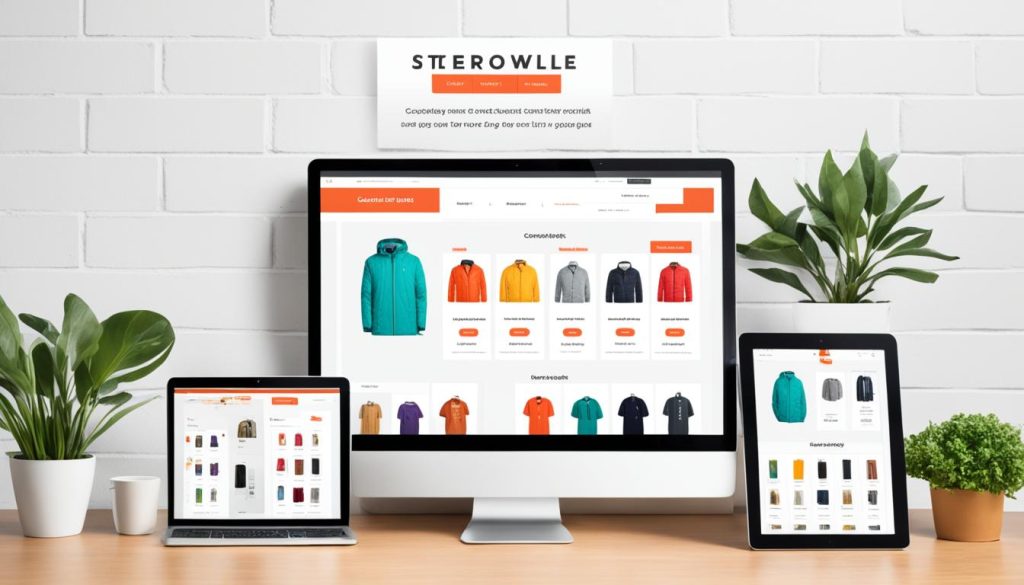How To Build An eCommerce Website (2024 Guide)
Did you know that e-commerce revenue in the U.S. is projected to exceed $1.3 trillion in the next three years? Building an eCommerce website is no longer just an option for businesses, but a necessity for tapping into this lucrative market and driving significant revenue growth.
In this comprehensive guide, I will provide you with valuable information on how to build a successful eCommerce website. From choosing the right content management system to customizing your site and creating product listings, these expert tips and best practices will set you on the path to building a thriving online store.
Key Takeaways:
- Building an eCommerce website is essential for businesses to tap into the projected $1.3 trillion e-commerce revenue in the U.S.
- Follow these expert tips and best practices to build a successful eCommerce website.
- Choosing the right content management system is the first step in building an eCommerce website.
- Customize your site and build out web pages to provide a seamless and enjoyable shopping experience for your customers.
- Keep up with the latest trends and best practices to stay ahead in the competitive eCommerce landscape.
Step 1: Choose Your Content Management System (CMS)
When it comes to building an eCommerce website, choosing the right content management system (CMS) is essential. Your CMS will serve as the foundation for your online store, making it crucial to select the one that aligns with your e-commerce goals and requirements. Here are some popular CMS options to consider:
- WordPress: WordPress is a highly customizable CMS that powers millions of websites, including e-commerce sites. It offers a wide range of themes, plugins, and extensions, making it suitable for those with advanced web design skills. With WordPress, you have complete control over your online store’s design and functionality. It also offers various e-commerce plugins, such as WooCommerce, to help you set up a fully-functional online store.
- Shopify: Shopify is a dedicated e-commerce platform that caters specifically to online businesses. It provides a user-friendly interface, extensive built-in features, and seamless integration with various payment gateways. Shopify is particularly suitable for dropshipping businesses, as it offers easy inventory management and order fulfillment.
- Squarespace: Squarespace is known for its sleek and professional website templates. It is beginner-friendly, requiring no previous web design experience. Squarespace offers intuitive drag-and-drop functionality and a variety of e-commerce features, making it ideal for small businesses that want to create an attractive online store quickly.
- Square Online: Square Online is designed specifically for existing retailers who want to expand their business online. It seamlessly integrates with Square’s point-of-sale system, allowing retailers to manage both their in-person and online sales from a single platform. Square Online offers a range of customizable templates and features to suit various e-commerce needs.
- Wix: Wix is an all-in-one website builder that allows users to create stunning websites without any coding knowledge. It offers a user-friendly drag-and-drop editor and a vast collection of templates to choose from. Wix also provides built-in e-commerce functionality, making it a great choice for small businesses or individuals who want an easy-to-use, customizable solution.
Consider your budget, technical skills, and specific e-commerce requirements when selecting a CMS. Each platform has its own strengths, so take the time to evaluate their features and choose the one that best fits your needs.
Now that you understand the importance of selecting the right CMS, let’s move on to the next step: creating an account or obtaining web hosting for your eCommerce website.
Step 2: Create an Account (Or Get Web Hosting)
Once you have chosen your CMS, the next step is to create an account or obtain web hosting. The process differs depending on the platform you have selected.
If you have chosen WordPress, you will need to get a web hosting plan that includes a free domain name, SSL certificate, and one-click WordPress installation. By obtaining web hosting, you secure a space on the internet for your website to reside. This allows your website to be accessible to users around the globe.
On the other hand, if you decide to use a website builder like Shopify, Squarespace, Square Online, or Wix, you can easily register for an account on their respective websites. These platforms provide an all-in-one solution, offering both the website building tools and the hosting services needed to publish your website.
It’s worth noting that some CMS platforms also offer domain name registration. However, if your chosen CMS does not provide this service, you will need to register your domain name through a domain name registrar. A domain name registrar is a company that manages the reservation of domain names. When selecting a registrar, it is crucial to choose a reputable and reliable one. Take the time to research and select the best domain name registrar for your needs.
By creating an account or obtaining web hosting, you are taking a significant step towards launching your eCommerce website. This process provides the foundation for your online presence, laying the groundwork for the rest of your website building journey.
Now that you have successfully secured your account or web hosting, you are ready to move on to the next step: selecting an e-commerce theme or template.

The Best Domain Name Registrars
| Domain Name Registrar | Features | Price Range |
|---|---|---|
| GoDaddy | Domain privacy, DNS management, easy domain transfer | $10-$20 per year |
| Namecheap | Free WHOIS protection, reliable customer support, easy-to-use interface | $7-$15 per year |
| Google Domains | Simple domain management, email forwarding, DNSSEC | $12-$20 per year |
| Bluehost | Free domain registration, domain privacy, advanced DNS management | Starting at $11.99 per year |
| HostGator | Free domain registration, domain privacy, DNS management | $12.95 per year |
Step 3: Select an E-commerce Theme or Template
After setting up your account or obtaining web hosting, the next step in building your eCommerce website is to select an e-commerce theme or template. Whether you are using WordPress, Shopify, Wix, or another CMS, there are plenty of options available to suit your needs.
When choosing an e-commerce theme or template, it’s essential to consider design and customization options. Many platforms offer a wide range of free templates, while others provide premium templates at a cost. Free templates can be a great starting point, especially if you have a limited budget. However, premium templates often offer more unique designs and advanced customization features, which can save you time and effort.
WordPress, one of the most popular CMS platforms, offers a vast library of themes. You can browse through their collection, filtering by industry or specific features, to find the perfect e-commerce theme for your website. Shopify, another popular choice, provides a wide range of professionally designed themes tailored specifically for online stores. Wix is known for its user-friendly website builder, which offers both free and premium templates for e-commerce websites.
By selecting an e-commerce theme or template, you can establish the overall look and feel of your website without having to start from scratch. This step not only saves time but also ensures your website has a visually appealing and cohesive design that resonates with your target audience.

Comparison of E-commerce Website Builders and Templates
| Content Management System | E-commerce Templates Available | Free Templates | Premium Templates |
|---|---|---|---|
| WordPress | Wide variety | Yes | Yes, at additional cost |
| Shopify | Professionally designed | No | Yes |
| Wix | Multiple options | Yes | Yes, at additional cost |
This table provides a brief comparison of commonly used CMS platforms and the availability of e-commerce templates. Depending on your specific requirements, budget, and customization needs, you can choose the platform that aligns best with your goals.
Step 4: Customize Your Site and Build Out Web Pages
Now that you have selected the perfect e-commerce theme or template for your website, it’s time to customize your site and build out the web pages. This step is crucial in creating a website that stands out and effectively represents your brand. Here are a few key areas to focus on:
Header and Footer: Customize the header and footer to include your logo, contact information, and links to important pages. This will ensure that your brand is prominently displayed throughout the site and provide easy access to essential information.
Site Navigation: Configure the site navigation to create a logical flow and make it easy for visitors to find what they are looking for. Use clear and descriptive labels for each menu item, and consider implementing dropdown menus for sub-categories, if applicable. This will enhance the user experience and encourage visitors to explore your website further.
Web Pages: Build out your web pages, starting with the homepage. Use engaging visuals and compelling copy to capture visitors’ attention and convey your brand story. Don’t forget to include an About Us page, a contact page, and any other relevant pages, such as FAQs, testimonials, and blog or news sections. Also, ensure that your refunds and return policy is clearly outlined, providing transparency and building trust with your customers.
Product Listings: Create product listings that are visually appealing and informative. Organize your products into categories, making it easy for customers to browse and search for specific items. Include high-quality images, detailed descriptions, pricing information, and any relevant product options or variations. This will help to showcase your products effectively and facilitate the purchasing process.
Remember, customization is key in creating a website that reflects your brand identity and provides an enjoyable shopping experience for your customers. Take the time to meticulously customize each element of your site, ensuring it aligns with your brand aesthetic and values. By doing so, you will set yourself apart from the competition and make a lasting impression on your website visitors.
FAQ
What is the first step in building an eCommerce website?
Which CMS options are available for building an eCommerce website?
What should I consider when choosing a CMS for my eCommerce website?
How do I create an account or obtain web hosting for my eCommerce website?
Where can I register a domain name for my eCommerce website?
How do I select an e-commerce theme or template for my website?
What should I customize on my eCommerce website?
- How Strategic SEO Drove Growth for a CPAP E-commerce Brand - July 24, 2025
- Top 3 SEO Companies in Toronto: An Analytical Comparison - July 23, 2025
- SEO for Entry Door Services - April 24, 2025





















Post Comment
You must be logged in to post a comment.